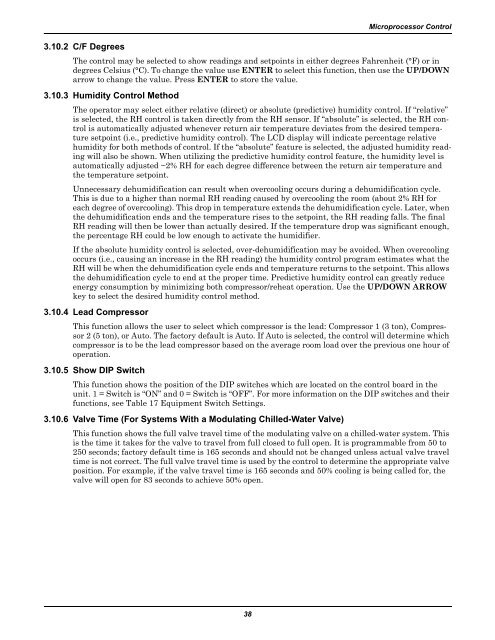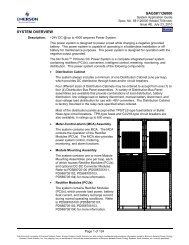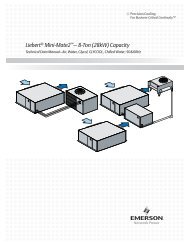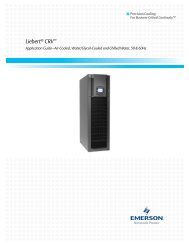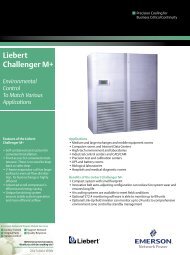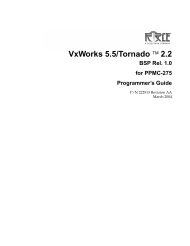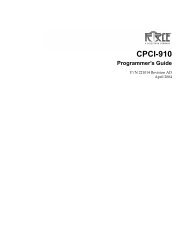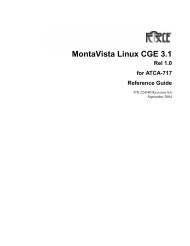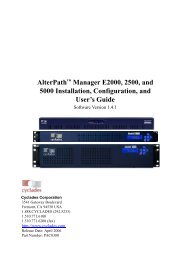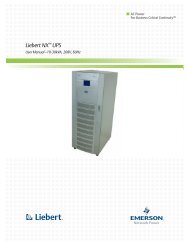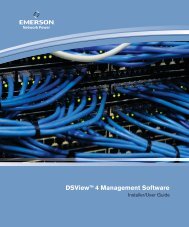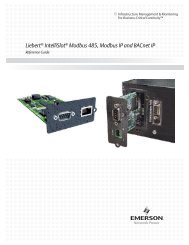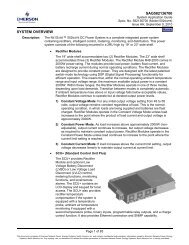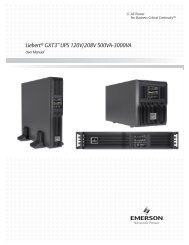Liebert Mini-Mate2, 8 Ton - Emerson Network Power
Liebert Mini-Mate2, 8 Ton - Emerson Network Power
Liebert Mini-Mate2, 8 Ton - Emerson Network Power
You also want an ePaper? Increase the reach of your titles
YUMPU automatically turns print PDFs into web optimized ePapers that Google loves.
3.10.2 C/F Degrees<br />
38<br />
Microprocessor Control<br />
The control may be selected to show readings and setpoints in either degrees Fahrenheit (°F) or in<br />
degrees Celsius (°C). To change the value use ENTER to select this function, then use the UP/DOWN<br />
arrow to change the value. Press ENTER to store the value.<br />
3.10.3 Humidity Control Method<br />
The operator may select either relative (direct) or absolute (predictive) humidity control. If “relative”<br />
is selected, the RH control is taken directly from the RH sensor. If “absolute” is selected, the RH control<br />
is automatically adjusted whenever return air temperature deviates from the desired temperature<br />
setpoint (i.e., predictive humidity control). The LCD display will indicate percentage relative<br />
humidity for both methods of control. If the “absolute” feature is selected, the adjusted humidity reading<br />
will also be shown. When utilizing the predictive humidity control feature, the humidity level is<br />
automatically adjusted ~2% RH for each degree difference between the return air temperature and<br />
the temperature setpoint.<br />
Unnecessary dehumidification can result when overcooling occurs during a dehumidification cycle.<br />
This is due to a higher than normal RH reading caused by overcooling the room (about 2% RH for<br />
each degree of overcooling). This drop in temperature extends the dehumidification cycle. Later, when<br />
the dehumidification ends and the temperature rises to the setpoint, the RH reading falls. The final<br />
RH reading will then be lower than actually desired. If the temperature drop was significant enough,<br />
the percentage RH could be low enough to activate the humidifier.<br />
If the absolute humidity control is selected, over-dehumidification may be avoided. When overcooling<br />
occurs (i.e., causing an increase in the RH reading) the humidity control program estimates what the<br />
RH will be when the dehumidification cycle ends and temperature returns to the setpoint. This allows<br />
the dehumidification cycle to end at the proper time. Predictive humidity control can greatly reduce<br />
energy consumption by minimizing both compressor/reheat operation. Use the UP/DOWN ARROW<br />
key to select the desired humidity control method.<br />
3.10.4 Lead Compressor<br />
This function allows the user to select which compressor is the lead: Compressor 1 (3 ton), Compressor<br />
2 (5 ton), or Auto. The factory default is Auto. If Auto is selected, the control will determine which<br />
compressor is to be the lead compressor based on the average room load over the previous one hour of<br />
operation.<br />
3.10.5 Show DIP Switch<br />
This function shows the position of the DIP switches which are located on the control board in the<br />
unit. 1 = Switch is “ON” and 0 = Switch is “OFF”. For more information on the DIP switches and their<br />
functions, see Table 17 Equipment Switch Settings.<br />
3.10.6 Valve Time (For Systems With a Modulating Chilled-Water Valve)<br />
This function shows the full valve travel time of the modulating valve on a chilled-water system. This<br />
is the time it takes for the valve to travel from full closed to full open. It is programmable from 50 to<br />
250 seconds; factory default time is 165 seconds and should not be changed unless actual valve travel<br />
time is not correct. The full valve travel time is used by the control to determine the appropriate valve<br />
position. For example, if the valve travel time is 165 seconds and 50% cooling is being called for, the<br />
valve will open for 83 seconds to achieve 50% open.


